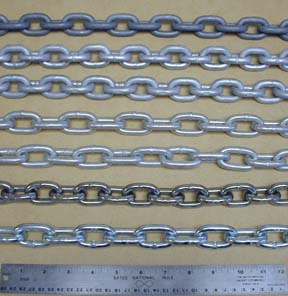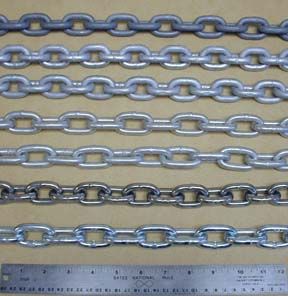We had an unpleasant, although not surprising, discovery this week as we revisited the topic of ground tackle. Many readers will recall that we began a series of mooring chain tests back in 2006, with corrosion reports in 2007 and in 2008. As one Practical Sailor tester put it, the test could be described as an attempt to determine how long it took our hard-earned money to turn into a pile of rust. (As it turned out, this happened a lot faster than we expected.)

At the end of 2.5 years in the water, when we decided that no one in their right mind would trust their boat to any of the seven badly corroded 5/16-inch chains, we pulled them out for the final inspection. We found varying levels of corrosion, with 20 percent less metal remaining in cheaper Asian-made links, as compared to the chain we eventually recommended from Acco (a brand that has since been purchased by Peerless Chain Co.). The Acco Grade 30 chain, in our view, seemed to be the best balance of price and corrosion resistance in a mooring chain.
After that report, the chains got shuttled from our test sight in Connecticut to our newer headquarters in Sarasota, Fla. And as often happens when a person or company makes a terrestrial move, the mooring chains wound up in a box labeled IMPORTANT, and were promptly forgotten. The box sat in a corner of our workshop for a couple of years, re-emerged during a much-needed house cleaning and were hung from a fence in the editors backyard as a constant reminder that it was high time he followed up on this test. And this week (finally!), that is what we did. Using sophisticated equipment at a Tampa, Fla., facility that specializes in testing industrial cables, wire, and hardware, we applied increasing loads to our mooring chains and recorded the load data (tensile strength) until they broke.
While you will have to wait for the upcoming report for the full results (soon-I promise), one finding needs to be shared here, in Practical Sailors free public forum: Dont rely on stainless-steel chain for mooring or anchoring.
Even though our stainless-steel chain sample clearly had more meat and was much shinier than our other samples at all stages of the test, it was one of the first to go in our test of breaking strength. The ease with which it broke was shocking, although we can’t say we were totally surprised.
For years, weve been warning sailors about the hidden dangers of stainless steel in mooring chains, lifelines, chainplates, anchor swivels, turnbuckles, rod-rigging, keel bolts-the list goes on and on. In many of these cases, we have not rejected the material, merely advocated careful selection of the appropriate grade (304, 316, 316L, etc.) and frequent inspection. Stainless steel remains the most practical choice for many other applications.
Although stainless steel is well-suited for fabricating a wide range of sailing hardware and equipment, we feel that it is a poor choice for anchor or mooring chain-and not just because it costs so much more than the usual choice, galvanized steel. One of stainless steel’s biggest vulnerabilities is the work hardening caused cyclical loading, the repeated “shock” loading that an anchor chain experiences. In simple terms, work hardening makes the metal brittle. Another vulnerability is crevice corrosion, which I wrote about last year.
Heres what we said about stainless-steel chain in 2007: Corrosion is just one of the factors affecting a chains integrity. With stainless steel in particular, disregarding work hardening under real mooring and anchoring loads involves a serious leap of faith (see “Marine Metals,” February 2007). Stainless steel sees so little use in high-load-cycle applications precisely because it does not hold up as well to this use as do materials with higher ferrous content. Its ever-shiny surface can actually be a disadvantage, revealing no clues to impending failure.
Bottom line: When it comes to anchor or mooring chain, what you can’t see can hurt you.









































Did the follow up to this article ever get published?